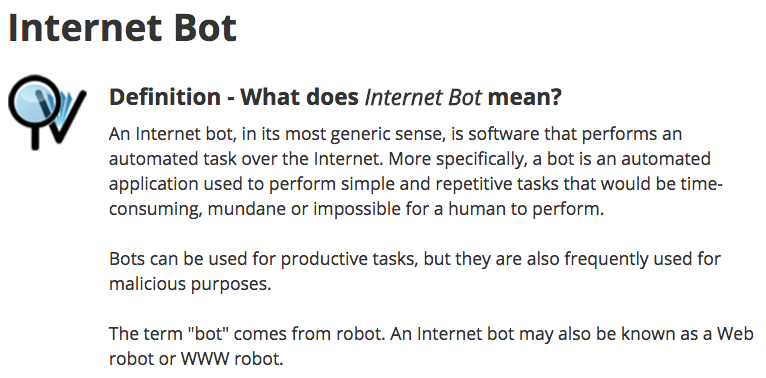Over the last several months, it’s been refreshing to see more and more automotive leaders shifting their focus from quantity to quality when it comes to their website traffic and overall marketing. Rather than holding value in the number of site visits, the value has shifted to the percent of visitors that either complete a lead form or show up at a dealership. In other words, traffic that is capable of converting into sales or service revenue is the most valuable, and it’s the only type dealers should be paying for. There is an undeniable growing need for technology that flags sources that drive bad traffic so that those sources can be eliminated.
When I say bad traffic, I’m referring to BOTS. Bots (defined below) are also referred to as Internet crawlers or spiders. There are both good and bad types of Internet bots, but none of them are human, and none of them are capable of purchasing or test-driving a vehicle. Bots have been around for years, yet so many marketers still suffer from “bot traffic denial” thinking it couldn’t possibly happen to them. The reality is, no website is safe from these digital creepers. If you’re paying for digital marketing, you are absolutely paying for bot traffic – unless you fight back.

Source: Techopedia
What’s The Big Problem?
The problem is SEVEN BILLION DOLLARS of wasted money. Orbee’s Q3 2016 Bot Traffic Report stated, “Bot traffic is a $7 billion problem for the advertising industry and with dealership digital marketing budgets averaging $30-50K per month, the automotive industry must address this issue to prevent massive waste in digital advertising spend.”
The setbacks these invasive pests present is incredibly simple. Dealers put a lot of trust (and a lot of money) into driving website visits when over half of their paid traffic could be derived from false or suspicious clicks. ClickZ warns advertisers, “Some non-human traffic is fraudulent and some merely causes a technical problem. Both kinds can cost advertisers a lot of money, whether intentionally or not.” Regardless of the type of bot, dealers and their advertising partners do not want bots clicking on their ads, generating bad traffic and sucking the life out of their finite monthly budget.
How Do I Avoid Bots?
When reviewing your vendor services, or if you’re considering a new advertising vendor, make sure to ask the questions that can save you thousands of dollars. Orbee recommends starting with the following questions:
- What measures do you have in place to detect bot traffic?
- What % of total traffic do you mark as bot traffic?
- What is your refund policy regarding bot traffic?
Conquest Automotive has defined 5 red flags dealers and their vendors should look out for to identify bot traffic:
- Percentage of Out of Market Visitors – If the majority of visits to the dealership’s website were outside of the dealership’s primary market area (PMA), it is characterized as abnormal traffic.
- Percentage of Desktop to Mobile Devices– If the percentage of visits to the dealership’s website from desktop devices is higher than 90%, it is characterized as abnormal traffic.
- Percentage of Windows Operating Systems– If the percentage of visits to the dealership’s website exceeded 90% Windows operating system devices, it is characterized as abnormal traffic.
- Percentage of Footer Link Clicks – If the visits to the dealership’s website triggered an abnormal number of visits to the dealership’s privacy or sitemap pages, it is characterized as abnormal traffic.
- Hours of Day Clicks– Most Clicks should come during normal hours, not in the middle of the night.
Remember that when all else fails, you can always trust the data. Data never lies. If you receive a report showing a high number of website visits but no engagements or conversions, you most likely have a case of the bots. If you are one of the thousands of dealers that use AutoHook, contact us and we will set up a feature that will trigger an alert to catch this type of activity…or lack there of it. There are also new technologies specifically made for attacking and exposing bots, while also alerting dealers of potential problems. PCG is one company taking big steps to expose the issue through the PCG Engagement Project and through tools like Vistadash that measure actual human engagement metrics across all your ad sources.
Better yet, come out to one of the upcoming Automotive Engagement Conferences (AEC), starting in Atlanta on March 23rd. AEC is seven-city national tour showing dealers how to measure consumer engagement to eliminate advertising BOTS, BLUNDERS, and BLOAT in their marketing investments. Learn more or register at http://pcgcompanies.com/aec/.








